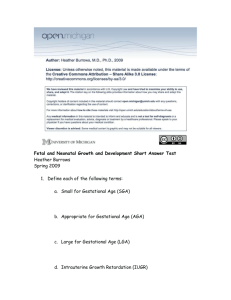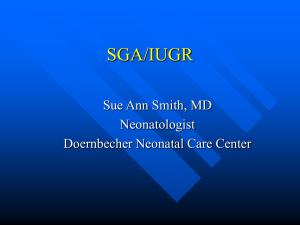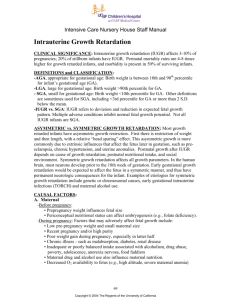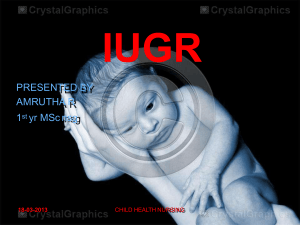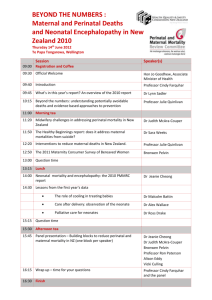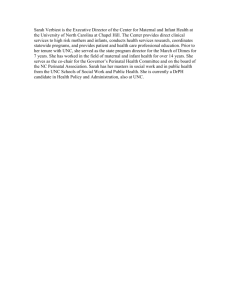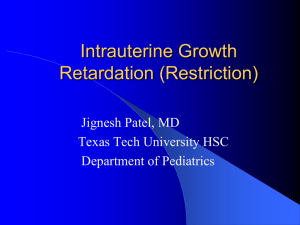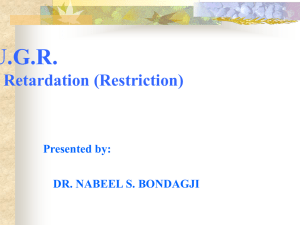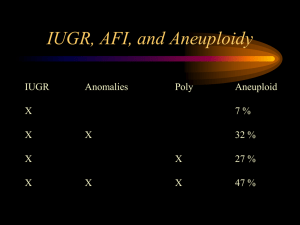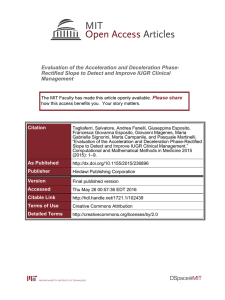INTRAUTERINE GROWTH RETARDATION
advertisement
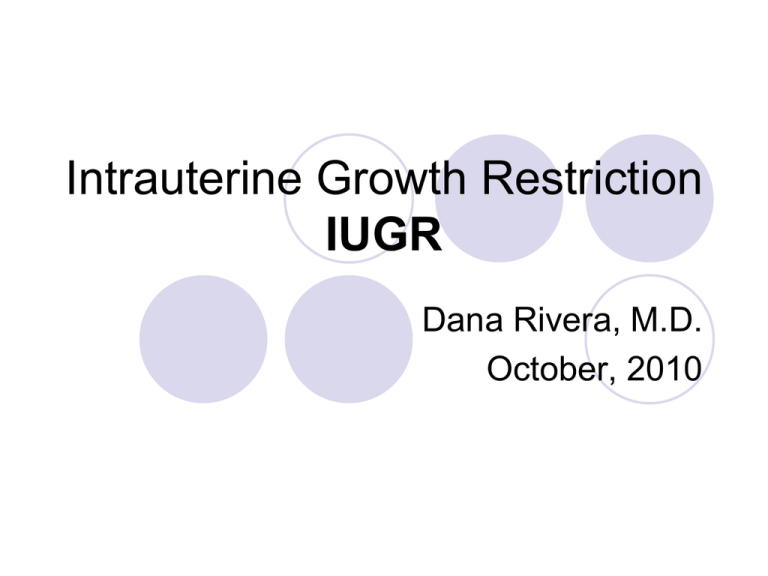
Intrauterine Growth Restriction IUGR Dana Rivera, M.D. October, 2010 SGA vs IUGR SGA: IUGR: BW less than population norms < 10th %-tile OR < 2 standard deviations below the mean (~3rd %-tile) pathologic or nonpathologic causes BW < expected inhibition of normal growth potential implies pathology True or False? All SGA infants are IUGR False All IUGR infants are SGA False Normal Intrauterine Growth Stage 1 Stage 2 Stage 3 Hyperplasia Hyperplasia/ hypertrophy Hypertrophy 4-20 weeks 20-28 weeks 28-40 weeks Rapid mitosis Declining mitosis Rapid hypertrophy Increasing DNA content Increasing cell size Rapid increasing cell size rapid accumulation of fat, muscle, connective tissue Symmetric Mixed- asymmetric Asymmetric Symmetric - Stage I growth inhibition Fewer cells but normal size - weight, head, length all < 10th percentile Perinatal problems? Higher Lower Growth potential? Higher Lower Asymmetric - Stage II/III growth inhibition Decrease in cell size, less effect on total cell number - weight below 10th percentile,head and length preserved Perinatal problems? Higher Lower Growth potential? Higher Lower What factors affect fetal weight? Sex term males 150 gm heavier and 0.9 cm longer than females Parity 1st born infants smaller effect loss after 3rd birth Race, ethnicity, nationality Altitude Denver population growth curves under estimate weights of infants born at sea level Maternal size maternal pre-pregnancy weight and pregnancy weight gain correlate with fetus size “Maternal constraint”- non-genetic Number of fetuses Reduced rate of fetal growth of multiples Small breed embryo transplanted into large breed uterus will grow larger Hormonal Factors Insulin Major hormone for in utero growth Produced by fetus Promotes fetal adipose deposition, glycogen stores Etiology- Overlapping Maternal, Fetal, Placenta Maternal factors Medical disease (US) Malnutrition (worldwide) Multiple pregnancy Drugs Hypoxemia Small stature/ low prepregnancy weight Teen pregnancy Low SES Prima gravida Grand multiparity Fetal Genetic Congenital malformations Genetic/ chromosomal (trisomies, syndromes) Cardiovascular disease Congenital infection Inborn errors of metabolism Placenta placental insufficiency post dates anatomic abnormal insertion hemangiomas infarcts abruption Case # 1 A baby is delivered at 36 WGA via repeat Csection BW- 2 kg HC- < 10th %tile Lt- < 10th %tile CMV Case #1- What if? Toxoplasmosis Rubella “TORCH” Stigmata hepatoslpenomegaly petechiae/ ecchymoses blueberry muffin rash vesicles/ mucocutaneous lesions chorioretinitis/ cataracts/ salt-pepper retinopathy PPS/PDA microcephaly/ hydrocephaly Intracranial calcifications Diagnosis Algorithm IUGR yes TORCH stigmata work-up? no Case # 2 A baby is delivered via NSVD, no prenatal care, EGA 35 weeks BW- 1500 gm HC- < 10th Lt- <10th Trisomy 13 Case #2- What if? Trisomy 18 Turner syndrome Diagnosis Algorithm IUGR yes TORCH stigmata work-up? no yes Dysmorphic features work-up? no Case # 3 Infant is delivered at 38 weeks to mom who presents with headaches and epigastric pain BW: 2.1 kg HC: 50th%tile Lt: 30th%tile Pre-eclampsia/ HELLP Case # 3- What if? Mom with no prenatal care delivers undiagnosed twins at EGA 34 weeks Discordant twins Case # 3- What if? An infant is delivered at 42 weeks via csection due to NRHTs after induction Post dates - decreased subcutaneous fat - skin desquamation - wizened facies - large AF(diminished membranous bone formation) - meconium staining Diagnosis Algorithm IUGR yes TORCH stigmata work-up? no yes Dysmorphic features work-up? no yes Maternal/placental explanation work-up? no Case # 3- What if? Infant delivered at EGA 34 weeks to mom with no prenatal care and positive tox screen Diagnosis Algorithm IUGR yes TORCH stigmata work-up? no yes Dysmorphic features work-up? no yes Maternal/placental explanation work-up? no yes Maternal drug use tox screen no Unknown cause True or False IUGR infants are prone to asphyxia Why or why not? Perinatal hypoxia Chronic and acute True Increased C/S rate, decreased Apgar, increased resuscitation need An IUGR infant is at risk for Hypothermia? decreased subcutaneous fat, increased surface- volume ratio, decreased heat production Hypoglycemia? decreased glycogen stores/ glycogenolysis/ gluconeogenesis increased metabolic rate deficient catecholamine release Or Hypocalcemia? Associated with perinatal stress, asphyxia, prematurity Which lab result(s) would not be associated with IUGR? WBC 4, S8 & B1 H & H 11/ 33 Plt 65 PT 16 PTT 56 Direct bilirubin 4.5 Neutropenia Polycythemia Elevated erythropoietin Thrombocytopenia Elevated coags TORCH Which CxR is more consistent with IUGR? Decreased surfactant deficiency Increased meconium aspiration Perinatal problems Perinatal asphyxia Hypothermia Hypoglycemia Hypocalcemia Polycythemia, hyperviscosity Thrombocytopenia Neutropenia Elevated coags Decreased surfactant deficiency Increased meconium aspiration syndrome Direct hyperbilirubinemia Evaluation and Management Physical exam Labs - blood sugar - urine shell vial (CMV) - calcium - viral cultures (HSV) - CBC diff/plt - syphilis w/u - bilirubin - tox screen - head ultrasound - chromosomes - total IgM vs specific Quick algorithm Evaluation and Management Monitor postnatal weight gain/ head growth needs may exceed 100-120 cal/kg/d catch- up by 6-12 months Hypersomatotropismaccelerated growth velocity ? Safety of aggressive feeding rapid weight gain may predispose to childhood obesity highest risk for developing type 2 DM IUGR- Outcome Neurodevelopment etiology and adverse event dependent lower intelligence, learning/ behavioral disorders, neurologic handicaps symmetric, chromosomal disorders, congenital infections--- poorer outcome school performance influenced by social class World’s smallest…..
